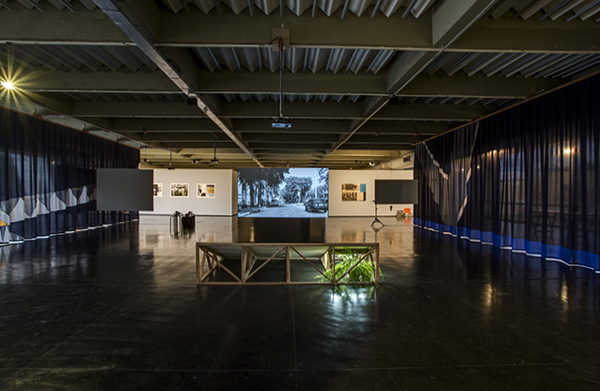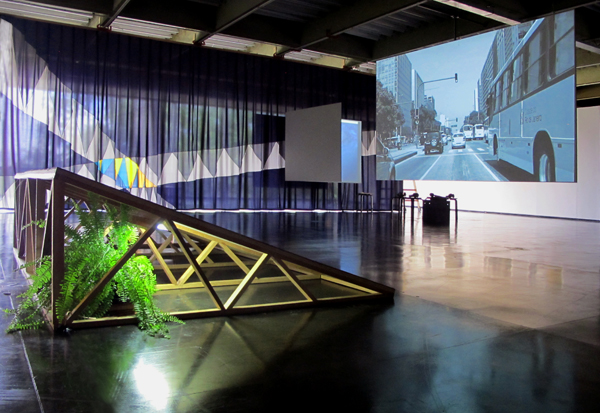Detour
Video installation
Video 1H, Loop, wooden display, fern, fluorescent light and 2 textile curtains
Various dimensions
In collaboration with Soraya Guimarães Hoepfner (text) and Birger Lipinski (curtains)
Solo exhibition – What ends every day, MAM – Museum of Modern Art, Rio de Janeiro, Brazil, 2015



Detour reflects on the historical importance of Lota de Macedo Soares, a self-taught architect and landscape designer, in the conceptualization and construction of Parque do Flamengo (Flamengo Park), which was inaugurated in 1965 in Rio de Janeiro. The installation brings to light Lota’s authorship in this urban project, and thereby aims to call attention to her erasure in Brazilian collective memory.
The work articulates a train of thought that highlights Lota’s life and her six years of non-remunerated work for Brazil’s public administration. As head of the enormous Grupo de Trabalho (Working Group) in Rio, she elaborated an urban intervention project for 296 acres of landfill along Guanabara Bay. She also implemented the ideas that shaped what is today the Parque do Flamengo (sited on the landfill), a massive recreational area informed by modern conceptions of politics, culture and urbanism for the city.
Detour also addresses the issue of gender as a category for reflection and, therefore, as a structure for the comprehension of the world. It suggests the various assumptions that, in a quintessentially patriarchal environment, created the conditions for the systematic erasure of Lota’s cultural achievements.
The film is composed of a single tracking shot that shows a route of approximately one hour, literally tracing the distance between two points: the public Museum of Modern Art/Rio (1953-55), which is situated in Flamengo Park, and the Casa Samambaia, a landmark of modern Brazilian architecture and her private home in the nearby mountainous area of Petrópolis, designed by archicthect Sergio Bernardes in the years 1951-53. She also lived in the house for many years with her partner, the American poet Elizabeth Bishop.
Black sequences interrupt the extended tracking shot and reproduce a soundtrack with narrative fragments that evoke differences between what is understood as public or private (here, The Museum of Modern Art/Flamengo Park and Casa Samambaia). The film thus presents a spatial and historical detour: it begins and ends with Lota’s contributions to public and private architectural projects and through the soundtrack calls upon visitors to reflect upon the possible motives for Lota’s absence from Brazilian collective memory.
Detour also features a wooden structure and 2 curtains. Raising the question of architecture, the tilted wooden structure that allows the audience to sit down and observe the film also resembles the roof construction at Casa Samambaia. Somewhat hidden underneath the structure a number of natural ferns (=samambaia in portuguese) are placed, materializing a direct relationship to the filmed detour to Petrópolis and Lota ́s home, Casa Samambaia.
The supporting beam of Casa Samambaia and the iconic concrete pillars of MAM are also reproduced in the curtains of this installation. Detour returns to two iconic buildings and settings in Brazilian modern architecture in order to emphasize Lota’s singularity and vital contributions when faced with her own time and pursuing her ideals. In so doing, the work also suggests how modernity and the project of historical memory remain incomplete projects in Brazil.
Photos:
Sérgio Araújo
